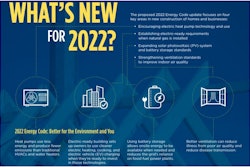
The New York City Department of Buildings announces that the 2020 NYC Energy Conservation Code will go into effect on May 12, 2020, and target all construction throughout the five boroughs.
"These strict energy standards will be applied to both new construction and existing buildings. These new standards are expected to cause a stir in the commercial sector as the cost of new construction is anticipated to increase substantially," according to coverage of the NYC rulemaking in Commercial Property Executive.
The 2020 NYC Energy Conservation Code is a local law to bring the New York City Energy Conservation Code up to date with 2020 Energy Conservation Construction Code of New York State, which is based on the 2018 edition of the International Energy Conversation Code and ASHRAE Standard 90.1-2016. The changes are designed to ensure that the construction of new buildings, additions and alterations will meet the 80% greenhouse gas reduction by 2050.
Notable highlights of the changes include:
Aligning with NYSERDA’s NYStretch Energy Code-2020 by aligning with the following provisions:
- Continuous insulation for balconies and parapets
- Mandatory supply ventilation provided with energy or heat recovery devices on homes and multifamily buildings three-stories and less
- More efficient interior lighting power requirements
- Additional lighting controls
- Additional thermal envelope performance requirements for buildings choosing to comply with energy modeling
- More stringent insulation and fenestration requirements for most assembly types
- Allowing source energy as a metric, instead of energy cost, for buildings choosing to comply with energy modeling
- Efficient design of service water heating distribution systems in one- and two-family homes and multifamily buildings 3 stories and less
- Whole building energy monitoring on commercial buildings
- Efficiency measures for certain traction elevators and commercial kitchen equipment
- Infrastructure for the future installation of electric vehicle chargers in one- and two-family homes
Adopting local provisions from Advisory Committee :
- Documentation of certain linear and point thermal bridges for all new construction
- Requiring more new construction projects to perform air leakage testing
- Increased HVAC efficiency to align with federal requirements
- Requiring more alteration projects to perform commissioning


















